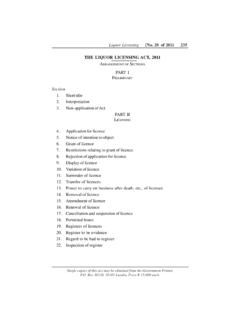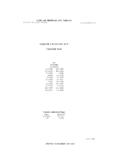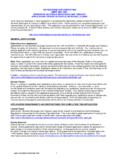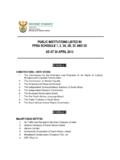Transcription of LIQUOR PRODUCTS ACT 60 OF 1989 - sawis.co.za
1 LIQUOR PRODUCTS ACT 60 OF 1989 REGULATIONS Published under Government Notice R1433 in Government Gazette 12558 of 29 June 1990 and amended by: 1 GN R838 GG 13159 19/4/91 20 GN R1078 GG 19174 28/8/98 2 GN R2841 GG 13646 29/11/91 21 GN R24 GG 19657 8/1/99 3 GN R2079 GG 14169 24/7/92 22 GN R70 GG 19688 22/1/99 4 GN R2593 GG 14267 11/9/92 23 GN R672 GG 20101 28/5/99 5 GN R2791 GG 14304 2/10/92 24 GN R951 GG 20330 6/8/99 6 GN R3152 GG 14410 20/11/92 25 GN R21 GG 21972 12/1/2001 7 GN R1376 GG 15014 30/7/93 26 GN R349 GG 22226 20/4/2001 8 GN R2350 GG 15312 10/12/93 27 GN R678 GG 22495 27/7/2001 9 GN R356 GG 15515 25/2/94 28 GN R343 GG 24967 7/3/2003 10 GN R636 GG 15607 8/4/94 29 GN R77 GG 28428 3/2/2006 11 GN R1022 GG 15761 27/5/94 30 GN R814 GG 29096 11/8/2006 12 GN R2242 GG 16183 23/12/94 31 GN R846 GG 30276 14/9/2007 13 GN R394 GG 16307 17/3/95 32 GN R171 GG 30769 15/2/2008 14 GN R1695 GG 16796 3/11/95 33 GN R555 GG 32234 22/5/2009 15 GN R1876 GG 16855 8/12/95 34
2 GN R413 GG 33193 21/5/2010 16 GN R501 GG 17060 29/3/96 35 GN R525 GG 35501 13/7/2012 17 GN R1038 GG 18182 8/8/97 36 GN R401 GG 37669 2/5/2014 18 GN R1141 GG 18224 29/8/97 37 GN R5 GG41370 5/1/2018 19 GN R833 GG 18992 26/6/98 GN R5/2018 replaced flavourant/s with flavouring/s throughout the Regulations The Minister of Agriculture has under section 27 of the LIQUOR PRODUCTS Act, 1989 (Act No. 60 of 1989) - (a) made the regulations in the Schedule; and (b) determined that the said regulations shall come into operation on 1 July 1990. SCHEDULE [Note: The figures and letters specified in square brackets at the headings of regulations denote the numbers of the applicable sections in the Act which serve as authority therefor.] Subdivision of regulations 1. Definitions Part 1 Production and compositional requirements 2.
3 Designated vine cultivars for wine 3. General requirements for wine 4. Designated classes for wine 5. Requirements for designated classes of wine 6. Designated classes for alcoholic fruit beverages 7. Production processes for alcoholic fruit beverages 8. Requirements for alcoholic fruit beverages 9. Designated raw materials and classes for spirits 10. Requirements for grape spirit 11. Requirements for husk spirit 11A. Requirements for premium husk spirit 12. Requirements for pot still brandy 13. Requirements for brandy 14. Requirements for vintage brandy 15. Requirements for whisky 16. Requirements for malt whisky 17. Requirements for blended whisky 18. Requirements for cane spirit 19. Requirements for rum 20.. 21. Requirements for gin 22. Requirements for vodka 23. Requirements for unspecified spirits 24.
4 Requirements for mixed spirits 25. Designated vine cultivars for grape-based liquors 26. Designated classes for grape-based liquors 27. Requirements for grape-based liquors 2 28. Designated classes for spirit-based liquors 29. Requirements for spirit-based liquors 30. Addition of substances to LIQUOR PRODUCTS 31. Removal of substances from LIQUOR PRODUCTS 32. Restricted substances in LIQUOR PRODUCTS Part 2 Labels and labelling requirements 33. Compulsory particulars on labels 34. Manner in which particulars must be indicated 35. Indication of class designation 36. Indication of alcohol content 37. Indication of country of origin 38. Indication of name and address or code number of responsible seller 38A. Indication of filling date 38B. Indication of lot identification 39. Prohibited practices and exemptions in connection with certain indications 39A.
5 Exemption from prohibition 40. Registration of code numbers 41 Additional presentation requirements Part 3 Import requirements 42. Exemptions 43. Application for import certificates 44. Exemption from payment of fees 45. Samples of PRODUCTS intended for import 46. Certificates of Analysis 47. Issuing of import certificates 48. Certificates of removal for imported LIQUOR PRODUCTS 49. Disposal of LIQUOR PRODUCTS imported in bulk Part 4 Export requirements 50. Exemptions 51. Applications for export certificates 52. Samples of PRODUCTS intended for export 53. Issuing of export certificates 54. Export directions Part 5 Miscellaneous provisions 55. Authorizations regarding alcoholic PRODUCTS 56. Control over the receipt, keeping and use of certain substances 56A. Keeping of records 57. Analysis of samples 58. Appeals 59.
6 Offences and penalties 60. Permissible tolerances 60A. Prohibition of lead coatings 61. Payment of fees 62. Addresses for submission of documents Table 1: Grape cultivars which may be used for the production of wine. Table 2: Classes for wine and specific requirements for classes. Table 3: Classes for alcoholic fruit beverages and fruit and alcohol content requirements for classes. Table 4: Classes and requirements for grape-based liquors. Table 5: Classes and requirements for spirit-based liquors. Table 6: Substances which may be added to LIQUOR PRODUCTS . Table 7: Substances which may be removed from LIQUOR PRODUCTS . Table 8: Restricted substances in LIQUOR PRODUCTS . Table 9: Letter sizes of indications on labels. Table 10: Permissable alternatives for class designations. Table 11: .. Table 12: Exempted countries.
7 Table 13: Permissible tolerances 3 1. Definitions [27 (l)] [To index] Any word or expression in these regulations to which a meaning has been assigned in the Act shall have that meaning and, unless the context otherwise indicates bottle means a container made of glass; certify means to grant authorization in terms of a scheme for the use of particulars referred to in section 11(3)(a) and (4) of the Act, in connection with the sale of wine; and certification has a corresponding meaning; code number means a code number registered or deemed to be registered in terms of regulation 40 in respect of the responsible seller of a LIQUOR product; concentrated must means (a) the liquid uncaramelised product obtained through the partial dehydration of must, and of which the specific gravity is at least 1,24; or (b) the solid uncaramelised product obtained by the crystallisation of liquid concentrated must without the use of solvents, and of which the specific gravity is at least after dilution for use; [Definition of concentrated must substituted by GN R5/2018] customs and excise officer means an officer referred to in section 1 of the Customs and Excise Act, 1964 (Act No.)
8 91 of 1964); "flavouring" means a substance not intended to be consumed as such, which is added in order to impart or modify odour or taste; [Definition of "flavourant" inserted by GN R401/2014 and amended to flavouring by GN R5/2018] customs and excise warehouse means a warehouse licensed in terms of section 19 of the Customs and Excise Act, 1964; fortified wine means wine to which a spirit derived from the fermented juice of the product of the grape vine has been added to such an extent that the alcohol content thereof is at least 15,0 per cent but does not exceed 22,0 per cent. [Definition of fortified wine substituted by GN R1078/98] fruit juice means the juice of fresh fruit, including reconstituted juice obtained from a concentrate of such juice or a mixture of such juice and such reconstituted juice, that is in such a condition that fermentation can occur in the undiluted juice; main label means the label normally facing the customer in most self-help retailers; [Definition of main label deleted by GN R1876/95 and re-inserted by GN R5/2018]] must means the juice of fresh grapes and that is in such a condition that alcoholic fermentation can occur in the undiluted juice; natural wine means wine of which the alcohol content is at least 4,5 per cent but less than 16,5 per cent.
9 [Definition of "natural wine" substituted by GN R401/2014] pressure means the total gaseous tension, measured at 20 C, in a container in which a LIQUOR product is sold; residual sugar content means the quantity of reducing sugar, calculated as a mass per volume, that is present in a LIQUOR product; responsible seller means a person by or on behalf of whom (a) a LIQUOR product is bottled with a view to the sale thereof by him in sealed containers; or (b) a LIQUOR product is imported in the sealed containers in which it is to be sold; 4 self-supporting , in relation to a container or packaging, means a container or packaging, which retains its original or assembled shape irrespective or whether it is filled or empty; [Definition of self-supporting inserted by GN R846/2007] sparkling wines means wines of the classes specified in items 10 to 17 of Table 2; sulphur dioxide content means the quantity of free and bound sulphur dioxide, expressed as a mass per volume, that is present in a LIQUOR product; sweet reserve means must which has undergone partial fermentation and of which the residual sugar content is at least 130 gram per litre; the Act means the LIQUOR PRODUCTS Act, 1989 (Act No.)
10 60 of 1989); unacceptable quality characteristics an unacceptability of a kind mentioned in Table 4 of the Wine of Origin Scheme, published by Government Notice No. R. 1434 of 29 June 1990; and [Definition of unacceptable quality characteristics inserted by GN R394/95] volatile acid content means the quantity of organic volatile acids, calculated as a mass of acetic acid per volume, that is present in a LIQUOR product. PART 1 PRODUCTION AND COMPOSITIONAL REQUIREMENTS 2. Designated vine cultivars for wine [5 (1) (a); 27 (1) (a)] [To index] (1) Grapes of the cultivars specified in Table 1 may be used for the production of wine. (2) Notwithstanding the provisions of subregulation (1), the board may on application approve that grapes of any other vine cultivar may also be used for the production of wine subject to such conditions and for such period as the board may determine.












